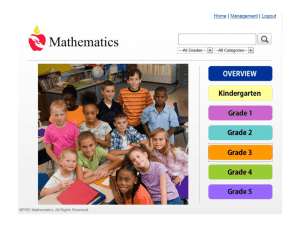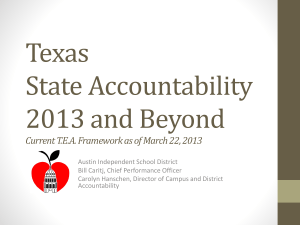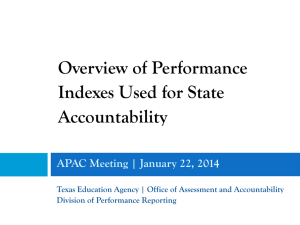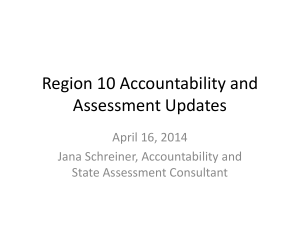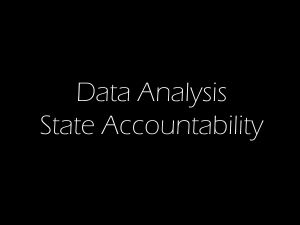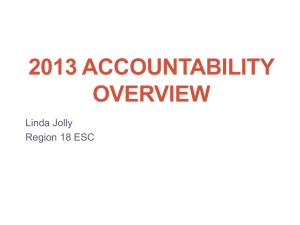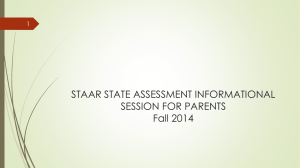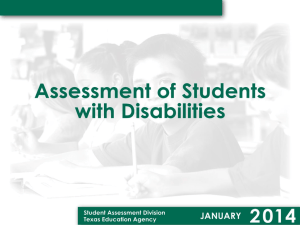Updated Powerpoint Slides
advertisement
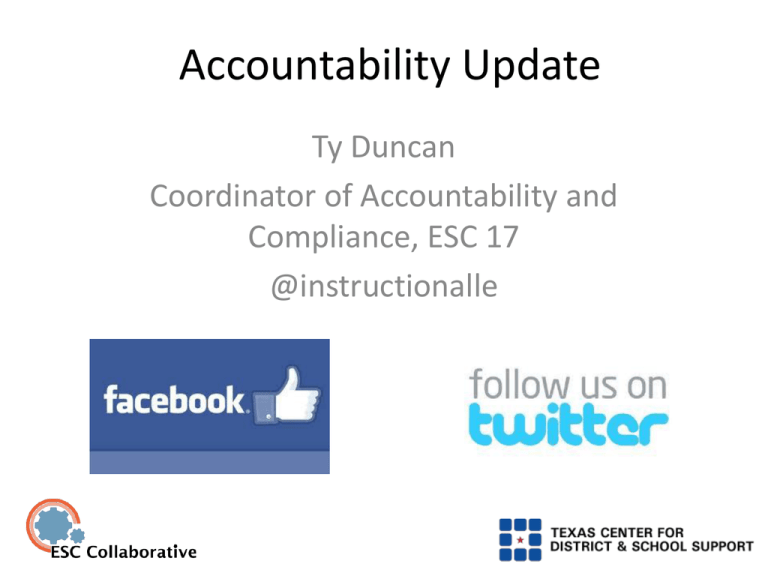
Accountability Update Ty Duncan Coordinator of Accountability and Compliance, ESC 17 @instructionalle Blog for Handouts!! Performance Index Framework For 2013 and beyond, a framework of four Performance Indexes will include a broad set of measures that provide a comprehensive evaluation of the entire campus or district. Student Student Achievement Achievement Index Index II Postsecondary Postsecondary Readiness Readiness Index44 Index Accountability System Student Student Progress Progress Index 2 Index 2 Closing Closing Performance Performance Gaps Gaps Index 3 Index 3 4 Overview of Proposed Performance Index Framework (Old Version) 5 Overview of Proposed Performance Index Framework (As of Feb. 28th, 2013) Index 1: Student Achievement Sample Campus STAAR Performance Results STAAR Performance Results % Met Level II or III STAAR Reading 50% STAAR Mathematics 38% STAAR Writing 45% STAAR Science 25% STAAR Social Studies 83% 7 Index 1: Student Achievement STAAR Percent Met Level II Standard (2013 and Beyond) STAAR Grades 3-8 English and Spanish at final Level II performance standard for assessments administered in the spring; EOC at final Level II performance standard for assessments administered in the spring and the previous fall and summer; STAAR Grades 3-8 and EOC Modified and Alternate at final Level II performance standard; TAKS 2013: Grade 11 results at Met Standard performance 2014 and beyond: None 8 Index 1: Student Achievement STAAR Percent Met Level II Standard (2013 and Beyond) Combined over all subject areas: Reading, Mathematics, Writing, Science, and Social Studies Student groups: All Students only Students below Grade 9 taking EOC courses: Administrative rules for the assessment program will require that students be administered the EOC test rather than the STAAR grade level assessment for the subject. 9 Index 1: Student Achievement Index 1 Construction Since Index 1 has only one indicator, the Total Index Points and Index Score are the same: Index Score = Total Index Points. Total Index Points is the percentage of assessments that met the final Level II Standard. Each percent of students meeting the final Level II performance standard contributes one point to the index. Index scores range from 0 to 100 for all campuses and districts. Example Mathematic s Reading Students Met Level II 50 Students Tested 100 + 38 Writing + 19 Social Studies Science + 10 + 19 Total = % Met Level II 136 45% + 100 + 42 + 40 + 23 = 45 305 Index Score 45 10 Index 2: Student Progress STAAR Percent Met Growth Standard (2014 and Beyond) The STAAR growth measure will not available in time for use in the 2013 accountability ratings. Since the growth measure must be finalized based on the spring 2013 STAAR results, it is not possible to set the 2013 accountability targets for Index 2 prior to the release date of the 2013 ratings. This graphic is an example of a transition table that divides the three STAAR performance levels (Level I, Level II, and Level III) into performance bands. The number of bands within a performance level may differ for the final growth measure adopted. 11 12 13 Index 2: Student Progress Index 2 Construction Ten Student Groups Evaluated: 1. 2. 3. All Students English language learners (ELLs) Students with Disabilities Race/Ethnicity: 4. African American 5. American Indian 6. Asian 7. Hispanic 8. Pacific Islander 9. White 10. Two or More Races 14 Index 2: Student Progress 15 Index 2: Student Progress Index 3: Closing Performance Gaps STAAR Weighted Performance (2013 and beyond) Two approaches to evaluating progress toward closing performance gaps: Compare the performance of the lower performing student group to the performance of a higher performing student group over time, or Compare the performance of the lower performing student group to an external target, the performance target that is tied to the statutory and accountability goal that Texas will be among the top ten states in postsecondary readiness by 2020 with no significant achievement gaps by race, ethnicity, or socioeconomic status. Index 3 takes the second approach through a weighted performance index. 17 Index 3: Closing Performance Gaps STAAR Weighted Performance (2013 and beyond) Index 3 ensures that individual student groups are not ignored within the performance index framework. Credit based on weighted performance: Level II satisfactory performance (2013 and beyond) One point for each percent of students at the final Level II satisfactory performance standard. Level II Final Performance(2014 and beyond) Two points for each percent of students at the final Level III advanced performance standard. 18 Index 3: Closing Performance Gaps Index 3 Construction Assessment results include all assessments that are included in the Index 1 student achievement indicator. By Subject Area: Reading, Mathematics, Writing, Science, and Social Studies. Student Groups Socioeconomic: Economically Disadvantaged Lowest Performing Race/Ethnicity: The two lowest performing race/ ethnicity student groups on the campus or district (based on prior-year assessment results). The STAAR weighted performance rate calculation must be modified for 2013 because STAAR Level III advanced performance cannot be included in the indicator until 2014. 19 Index 3: Closing Performance Gaps Index 3 Construction 20 20 Index 3: Closing Performance Gaps Index 4: Postsecondary Readiness 22 Index 4: Postsecondary Readiness 23 Index 4: Postsecondary Readiness Graduation Rates High School Graduation Four-year Graduation Rate or Five-year Graduation Rate (or Annual Dropout Rate if no graduation rate) Ten Student Groups Evaluated: 1. 2. 3. All Students English language learners (ELLs) Students with Disabilities Race/Ethnicity: 4. African American 5. American Indian 6. Asian 7. Hispanic 8. Pacific Islander 9. White 10. Two or More Races 24 Index 4: Postsecondary Readiness Recommended High School Program/Advanced High School Program RHSP/AHSP indicators are calculated for campuses and districts for which a graduation rate is calculated. Eight Student Groups Evaluated: 1. All Students Race/Ethnicity: 2. African American 3. American Indian 4. Asian 5. Hispanic 6. Pacific Islander 7. White 8. Two or More Races 25 Index 4: Postsecondary Readiness Index 4 Construction Graduation Score: Combined performance across the graduation and dropout rates for Grade 9-12 Grade 9-12 Four-Year Graduation Rate for All Students and all student groups OR Five-Year Graduation Rate for All Students and all student groups, whichever contributes the higher number of points to the index. One of the two rates is used, not a mix of Four-Year Graduation Rate for one student group and Five-Year Graduation Rate for another student group. RHSP/AHSP Graduates for All Students and race/ethnicity student groups STAAR Score: STAAR Percent Met Level III for All Students and race/ethnicity student groups (2014 and beyond) For high schools that do not have a graduation rate, the annual dropout rate and STAAR Level III performance contribute points to the index. For elementary and middle schools, only STAAR Level III performance contributes points to the index. 26 Index 4: Postsecondary Readiness Index 4 Construction 27 Index 4: Postsecondary Readiness Index 4 Construction 28 Overview of Proposed Performance Index Framework (As of Feb. 28th, 2013) Rating Labels? Implications • A focus on every kid and perhaps a renewed emphasis on SLR. • Growth mindset at the secondary level? • A renewed emphasis on serving the brightest and high achieving students. • Not easy for stakeholders to understand Bibliography • Lead4ward -- http://lead4ward.com/ • TEA Accountability http://ritter.tea.state.tx.us/perfreport/account/2 013/index.html
